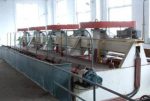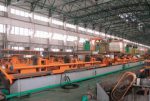-
Address: N0.2555,Xiupu Road, Kangqiao
Industrial Area, Pudong, Shanghai -
Call Us: (+86) 021-51095338
[email protected]
Solve the problem of material blockage in wet mill
During the operation of the wet mill, material blockage sometimes occurs. How to solve this trouble?
(1) The discharge pipeline is not smooth or blocked. Feeding too fast will block the air outlet of the wet mill; improper matching with the conveying equipment will cause the discharge pipeline to be blocked or blocked after no wind. After the fault is detected, the unmatched conveying equipment should be cleared first, and the feeding amount should be adjusted to make the equipment operate normally.
(2) Hammer fragments, aging, closed or broken screen holes, and high water content of the crushed materials will block the crusher. The broken and severely aged hammers of the wet mill should be updated regularly to keep the crusher in good working condition and check the screen regularly. The moisture content of the crushed material should be less than 14%, which can improve the production efficiency and make the crusher No clogging, enhancing the reliability of the crusher.
(3) The feeding speed is too fast and the load increases, causing blockage. During the feeding process, always pay attention to the large deflection angle of the ammeter pointer. If it exceeds the rated current, it indicates that the motor is overloaded, and the motor will be burned out if overloaded for a long time. When this happens, the feed door should be reduced or closed immediately, or the feeding method can be changed, and the feed amount can be controlled by increasing the feeder. There are two types of feeders: manual and automatic. The user should choose the appropriate feeder according to the actual situation. Due to the high speed of the wet mill, the large load, and the strong fluctuation of the load. Therefore, the current when the wet mill works is generally controlled at about 85% of the rated current.





